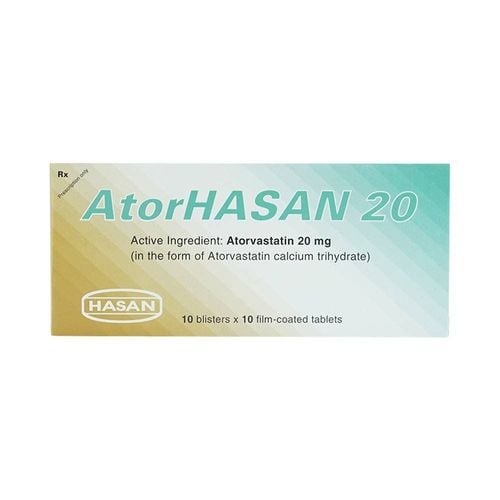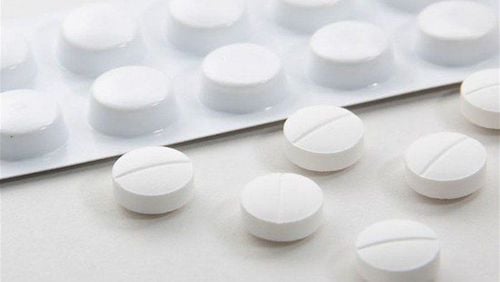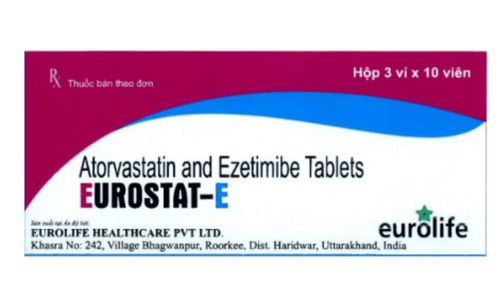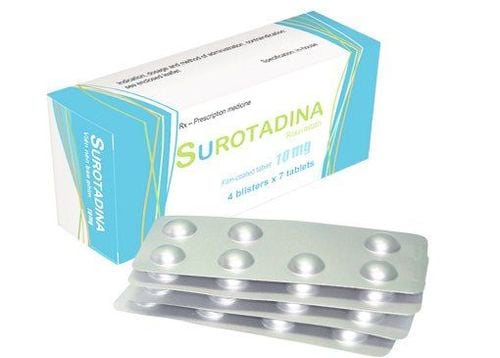This is an automatically translated article.
Atorhasan 10 is a product of Ha san-Dermapharm Co., Ltd., with effective treatment of hyperlipidemia. Complying with the indications, the dose of Atorhasan 10 will help patients improve the effectiveness of treatment and avoid unwanted side effects.
1. What are the uses of Atorhasan 10?
1.1. What is Atorhasan 10? Atorhasan 10 belongs to the group of drugs for treating dyslipidemia, with registration number VD-23327-15, manufactured by Ha san - Dermapharm - Vietnam Co., Ltd.
Atorhasan 10 medicine includes the following ingredients:
Main active ingredient: Atorvastatin Calcium Trihydrate 10mg equivalent to 10mg Atorvastatin. Excipients: Lactose Monohydrate, Sodium Croscarmellose, Calcium Carbonate, Sodium Lauryl Sulfate, Magnesium Stearate, Avicel M101, Prejel PAS, HPMC 615, HPMC 606, PEG 6000, Titanium Dioxide, Talc powder. The drug is made in the form of 10mg tablets, blisters of 10 tablets, boxes of 3 blisters or boxes of 10 blisters.
Atorhasan 10 is recommended for use in children 10 years of age and older and adults.
1.2. What does Atorhasan 10 do? Atorvastatin is a synthetic lipid-lowering drug, which has the effect of reducing total cholesterol, LDL-cholesterol, VLDL-cholesterol and increasing HDL-cholesterol.
Atorvastatin is effective in lowering LDL in patients with homozygous hereditary hyperlipidemia, a population that has not responded normally to other lipid-lowering agents.
Atorhasan 10 is prescribed by a doctor for use in the following cases:
Treatment of hypercholesterolemia (or in other words, lowering cholesterol): Support for diet to reduce total cholesterol, LDL cholesterol, apolipoprotein B and triglycerides in adults, adolescents and children 10 years of age and older. Reducing primary hypercholesterolemia includes: Hereditary hypercholesterolemia (heterozygous variant); combined hyperlipidemia (class IIa and Iib of the Fredrickson classification, respectively) in the absence of an adequate response to diet and other non-pharmacological treatments; adjunct to another lipid-lowering treatment (eg, LDL aphersis) or if such treatment is not available to lower total cholesterol and LDL-C in adults with homozygous hereditary hypercholesterolemia. Intermittent (level 1) prevention of coronary events: In patients with hypercholesterolemia without clinically evident coronary events, HMG-CoA reductase inhibitors such as Atorvastatin are indicated to: Reduce the risk of infarction heart muscle. Reduce the risk of having to undergo coronary revascularization procedures. Reduce the risk of death from cardiovascular disease.
2. How to use, dosage of Atorhasan 10
How to use Atorhasan 10:
The drug is made in the form of convenient tablets for oral administration. Initiate treatment with the lowest effective dose, then, if necessary, adjust the dose according to individual needs and response by increasing the dose at intervals of not less than 4 weeks and monitoring the Adverse drug reactions, especially those of the muscular system. Patients should adhere to a low cholesterol diet, before and during atorvastatin use. Take a single dose at any time of the day, with a meal or on an empty stomach. Take the medicine with a sufficient amount of filtered water. Do not break, chew or crush, but swallow the whole tablet. Do not mix the drug with any other mixture. Dosage of Atorhasan 10:
Adults: Initial dose: 1-2 tablets/time/day. Patients who need a significant reduction in LDL cholesterol (more than 45%) can start with a dose of 4 tablets once a day. Maintenance dose: 1-8 tablets/time/day. The dose may be adjusted at 4-week intervals to a dose of 8 tablets/day. Children (from 10 to 17 years old) with hypercholesterolemia, heterozygous familial hypercholesterolemia, combined hyperlipidemia: Initial dose: 1 tablet/time/day. Adjust dose if necessary, at least 4 weeks apart with a maximum dose of 2 tablets/time/day. No dose adjustment is required in patients with renal impairment. When used in combination with other drugs: When atorvastatin is used in combination with amiodarone, do not take more than 20 mg of atorvastatin/day. When used in combination with darunavir + ritonavir, fosamprenavir, fosamprenavir + ritonavir, saquinavir + ritonavir, do not use more than 20 mg of atorvastatin/day. When co-administered with nelfinavir, do not exceed 40 mg of atorvastatin/day. When lopinavir + ritonavir is co-administered with atorvastatin, caution should be exercised and if necessary the lowest dose should be used. Treatment for missed dose:
If you miss a dose, take it as soon as possible. However, if it is almost time for your next dose, skip the missed dose and take your next dose at the scheduled time. Note that double the prescribed dose should not be taken. Treatment of Overdose:
There is currently no specific treatment for patients with Atorvastatin overdose. In case of drug overdose, patients are basically treated symptomatically and intervened with supportive measures when necessary. Because most of Atorhasan 10 is bound to plasma proteins, hemodialysis hardly increases drug elimination from the body.
3. Contraindications of Atorhasan 10
Patients who are allergic to the main active ingredient Atorvastatin or any of the excipients listed above in Atorhasan 10 Patients with advanced liver disease or persistent elevation of serum transaminases without find the cause. Women who are pregnant or planning to become pregnant, women during lactation. Combination of atorvastatin with tipranavir + ritonavir, telaprevir.
4. Notes when using Atorhasan 10
Use of lipid-lowering drugs is only an intervention for multiple risk factors in patients at increased risk of atherosclerotic vascular disease due to hypercholesterolemia. Lipid-lowering agents should be used in conjunction with a low-saturated fat, low-cholesterol diet and only when there is an inadequate response to diet and other non-pharmacological measures. Before treatment with Atorvastatin, it is necessary to rule out secondary causes of elevated cholesterol (eg, uncontrolled diabetes, hypothyroidism, nephrotic syndrome, dysproteinemia, obstructive liver disease, alcoholism, etc.). ..) and need to check blood lipids. Liver function test should be done before drug treatment, during drug use, liver function should be monitored regularly. Use caution when administering the drug to patients who are alcoholics, or who drink heavily with a history of liver disease. Patients should be warned about the risk of muscle problems such as myalgia, muscle tension, or unexplained weakness. Increased risk of muscle damage when statins are used concurrently with: Gemfibrozil, other fibrate-lowering agents, high-dose niacin (> 1g/day), colchicine. Concomitant use of statins with anti-HIV and hepatitis C drugs may increase the risk of muscle damage, most seriously causing rhabdomyolysis, kidney failure leading to renal failure and possibly renal failure. deadly. Generally, the drug does not affect the ability to drive and use machines. However, the drug can cause dizziness and lightheadedness in some people. Do not drive, operate machinery or do anything dangerous if you feel dizzy or dizzy. Inform your doctor about all the medicines you are taking (including prescription and over-the-counter medicines, vitamins and minerals, dietary supplements, herbs) to limit the interaction of Atorhasan 10 with other medications. you are using to reduce absorption or harm your health. Do not use atorvastatin in pregnant women. Atorvastatin should only be used in women of childbearing age when effective contraception is available. If a woman becomes pregnant while taking this medicine, she should stop taking it and tell her doctor. It is not known whether atorvastatin is excreted in human milk. Because of the potential for atorvastatin to cause serious adverse effects in a nursing infant, atorvastatin should not be administered to a nursing woman.
5. Side effects of the drug Atorhasan 10
Common:
Digestive system: Diarrhea, constipation, bloating and nausea. Nervous system: Headache, dizziness, blurred vision, insomnia. Body as a whole: Weakness. Musculoskeletal system: Muscle pain, joint pain. Liver: affects liver function. Uncommon:
Myopathy (combined muscle weakness and increased plasma creatine phosphokinase); skin rash; rhinitis, sinusitis, pharyngitis, cough. Rare:
Myositis, rhabdomyolysis, leading to acute renal failure secondary to myoglobinuria, cognitive impairment (such as memory loss, confusion...), hyperglycemia, increased HbA1c.
6. How to store Atorhasan 10
Use Atorhasan 10 within 36 months from the date of manufacture. Store in a cool, dry place, at a temperature not exceeding 30°C, in the original packaging and protected from light. Keep out of reach of CHILDREN. Above is all information about Atorhasan 10 drug, patients need to carefully read the instructions for use, consult a doctor / pharmacist before using. Absolutely do not arbitrarily buy Atorhasan 10 home treatment because it may encounter unwanted side effects.
Please dial HOTLINE for more information or register for an appointment HERE. Download MyVinmec app to make appointments faster and to manage your bookings easily.













